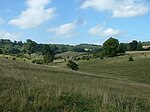Natural History Museum at Tring
Buildings and structures completed in 1889Museums established in 1892Museums in HertfordshireNatural History Museum, LondonNatural history museums in England ... and 2 more
TringUse British English from February 2023

The Natural History Museum at Tring was the private museum of Lionel Walter, 2nd Baron Rothschild; today it is under the control of the Natural History Museum, London. It houses one of the finest collections of stuffed mammals, birds, reptiles and insects in the United Kingdom. It was known as the Walter Rothschild Zoological Museum until April 2007. The museum is located on Akeman Street, in Tring, Hertfordshire.
Excerpt from the Wikipedia article Natural History Museum at Tring (License: CC BY-SA 3.0, Authors, Images).Natural History Museum at Tring
Akeman Street, Dacorum
Geographical coordinates (GPS) Address Website External links Nearby Places Show on map
Geographical coordinates (GPS)
| Latitude | Longitude |
|---|---|
| N 51.790833 ° | E -0.661368 ° |
Address
Natural History Musuem at Tring
Akeman Street
HP23 6AP Dacorum
England, United Kingdom
Open on Google Maps







